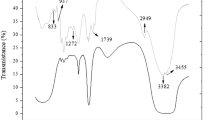Abstract
This study aimed to evaluate the antioxidant activities of a cultured medicinal fungus—Armillariella mellea (Vahl. ex Fr.) Karst. (AM). Three antioxidant assay systems, namely cytochrome c, xanthine oxidase inhibition, and FeCl2-ascorbic acid stimulated lipid peroxidation in rat tissue homogenate tests, were used. Total flavonoid and phenol contents of AM extracts were also analyzed. Results showed that both aqueous (AM-H2O) and ethanolic (AM-EtOH) extracts of solid state cultured AM showed antioxidant activities in a concentration-dependent manner. At concentrations 1–100 μg/ml, the free radical scavenging activity was 73.7–92.1% for AM-H2O, and 60.0–90.8% for AM-EtOH. These extracts also showed an inhibitory effect on xanthine oxidase activity, but with a lesser potency (IC50 is 9.17 μg/ml for AM-H2O and 7.48 μg/ml for AM-EtOH). In general, AM-H2O showed a stronger antilipid peroxidation activity on different rat’s tissues than AM-EtOH. However, both AM extracts displayed a weak inhibitory effect on lipid peroxidation in plasma. Interestingly, the antilipid peroxidation activity of AM-H2O (IC50–6.66 μg/ml) in brain homogenate was as good as IC50–5.42 μg/ml. AM-H2O (80.0 mg/g) possessed a significantly higher concentration of total flavonoids than AM-EtOH (30.0 mg/g), whereas no difference was noted in the total phenol content between these two extracts. These results conclude that AM extracts possess potent free radical scavenging and antilipid peroxidation activities, especially the AM-H2O in the brain homogenate.
Similar content being viewed by others
References
Bulkley, G.B., Surgery, 1983, vol. 94, no. 4, pp. 407–411.
Dormandy, T.L., Lancet, 1983, vol. 2, no. 8359, pp. 1010–1014.
Ceriello, A., Metabolism, 2000, vol. 49, no. 1, pp. 27–29.
Ames, B.N., Gold, L.S., and Willet, W.C., Proc. Natl. Acad. Sci. USA, 1995, vol. 92, no. 12, pp. 5258–5265.
Diaz, M.N., Frei, B., and Keaney, J.F., New Engl. J. Med., 1997, vol. 337, no. 6, pp. 408–416.
Christen, Y., Am. J. Clin. Nutr., 2000, vol. 71, no. 2, pp. 621S–629S.
Lang, A.E. and Lozano, A.M., New Engl. J. Med., 1998, vol. 339, no. 16, pp. 111–114.
Cheng, H.Y., Lin, T.C., Yu, K.H., Yang, C.M., and Lin, C.C., Biol. Pharm. Bull., 2003, vol. 26, no. 9, pp. 1331–1335.
Halliwell, B. and Gutteridge, J.M.C., Methods Enzymol., 1990, vol. 186, pp. 1–85.
Davies, K.J.A., IUBMB Life, 2000, vol. 50, nos. 4–5, pp. 279–289.
Young, L.S. and Woodside, J.V., J. Clin. Pathol., 2001, vol. 54, no. 3, pp. 176–186.
Gao, J.M., Yang, X., Wang, C.Y., and Liu, J.K., Fitoterapia, 2001, vol. 72, no. 8, pp. 858–864.
Yang, J.S., Chen, Y.W., Feng, X.Z., Yu, D.Q., and Liang, X.T., Planta Med., 1989, vol. 50, no. 4, pp. 288–290.
Momose, I., Sekizawa, R., Hosokawa, N., Iinuma, H., Matsui, S., Nakamura, H., Naganawa, H., Hamada, M., and Takeuchi, T., J. Antibiot. (Tokyo), 2000, vol. 53, pp. 137–143.
Kim, J.H. and Kim, Y.S., Biosci. Biotechnol. Biochem., 1999, vol. 63, no. 12, pp. 2130–2136.
Lowry, O.H., Rosebrough, N.J., Farr, A.L., and Randall, R.J., J. Biol. Chem., 1951, vol. 193, no. 1, pp. 265–275.
McCord, J.M. and Fridovich, I., J. Biol. Chem., 1969, vol. 244, no. 22, pp. 6049–6055.
Chang, W.S., Chang, Y.H., Lu, F.J., and Chiang, H.C., Anticancer Res., 1994, vol. 14, no. 2A, pp. 501–506.
Yoshiyuki, K., Michinori, K., Tadato, T., Shigeru, A., and Hiromichi, O., Chem. Pharm. Bull., 1981, vol. 29, no. 12, pp. 2610–2617.
Wong, S.H., Knight, J.A., Hopfer, S.M., Zaharia, O., Leach, C.N., and Sunderman, F.W., Clin. Chem., 1987, vol. 33, no. 2, pp. 214–220.
Zou, Y.P., Lu, Y.H., and Wei, D.Z., J. Agric. Food Chem., 2004, vol. 52, no. 16, pp. 5032–5039.
Cliffe, S., Fawer, M.S., Maier, G., Takata, K., and Ritter, G., J. Agric. Food Chem., 1994, vol. 42, no. 6, pp. 1824–1848.
Rouach, H., Ribiere, C., Park, M.K., Saffar, C., and Nordmann, R.R., Bioelectrochem. Bioenerg., 1987, vol. 18, nos. 1–3, pp. 211–217.
Author information
Authors and Affiliations
Additional information
Published in Russian in Prikladnaya Biokhimiya i Mikrobiologiya, 2007, Vol. 43, No. 4, pp. 495–500.
The text was submitted by the authors in English.
Rights and permissions
About this article
Cite this article
Ng, L.T., Wu, S.J., Tsai, J.Y. et al. Antioxidant activities of cultured Armillariella mellea . Appl Biochem Microbiol 43, 444–448 (2007). https://doi.org/10.1134/S0003683807040151
Received:
Issue Date:
DOI: https://doi.org/10.1134/S0003683807040151




